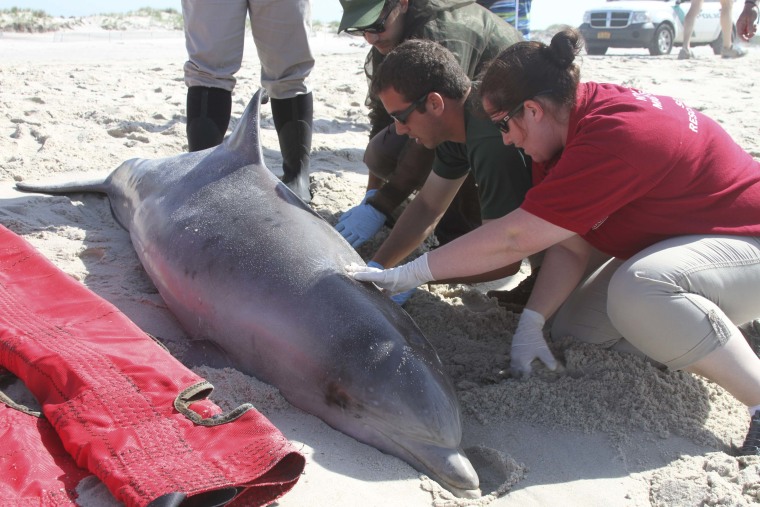The viral epidemic that's killing off mid-Atlantic bottlenose dolphins is entering its fourth month and there is no slow down in sight. The body count has crossed 600, and this "unusual mortality event" is set to upstage the last major dolphin die-off — one in 1987 and 1988 that killed some 700 bottlenoses — as the worst die-off yet.
Now, the government shutdown is threatening to stall the investigation of the event, leaving research centers with freezers full of dead dolphins and not enough scientists to study them.
"If this [shutdown] runs into weeks and longer, we're talking about significant impacts to our ability to investigate this mortality event," Mark Swingle, director of research and conservation at the Virginia Aquarium and Marine Science Center, told NBC News.
The dolphins are migrating south, and Virginia, the hardest hit state, seems to be past the worst of it: only 80 strandings in September, down from 172 dolphins in August. But the pace is "still demanding," Swingle said. The center relied heavily on volunteer responders and researchers, some of who have been furloughed because of the shutdown.
When a dolphin stricken by the morbillivirus is beached, staff members and volunteers drive carcasses from the shore to the lab, then conduct necropsies and collect samples to send along to other labs for testing — a task than can take up to seven hours. "If you remove people from any of those points, we're going to slow down," Swingle said.
While there may not be a cure for the epidemic, there's a window of opportunity to search for its causes, and whether any human behavior could have triggered it, or is making it worse.
Skeleton crews remaining at the center will continue to process new arrivals, and are stashing dolphins that they won't get to within 24 hours in a walk-in freezer. "We're getting in so many animals, and these animals are big," Swingle said. Mounting backlog means they'll run out of space in their walk-in freezer in about two weeks, which means valuable evidence from newly beached dolphins may be lost.
Conducting necropsies and salvaging slices of tissue is just the first step. Those samples are sent across the country for a battery of pathology and genetic tests. NOAA researchers are in charge of coordinating that exchange, but furloughs have brought that operation to a standstill. Tissue samples, like whole dolphins, will also be iced.
Meanwhile the effort itself is running on fumes. After dealing with 25 times the monthly strandings in August alone, the center has blown through the annual $100,000 in federal funding budgeted for marine mammal strandings, part of the national John H. Prescott Marine Mammal Rescue Assistance Grant Program. Swingle has applied for $60,000 in emergency funds to cover the bills through the rest of the season, but that's being evaluated by the National Fish and Wildlife Foundation. He expects that the shutdown will slow down that approval.
And there are bigger problems on the horizon. President Obama's proposed FY2013 budget makes no mention of the Prescott program, eliminating federal funding for marine mammal rescue for the first time in 13 years. Which leaves organizations like the Virginia Aquarium looking for private funding to make up the 20 percent of their annual budget that would be lost if Prescott is cut. "We don't have any other sources of government support," Swingle said. "This was it."
More about the dolphin die-off:
- Big break in die-off: It's an 'outbreak' of measles-like virus
- Hundreds of dolphins may die before killer is identified
Nidhi Subbaraman writes about science and technology. You can follow her on Facebook, Twitter and Google+.
